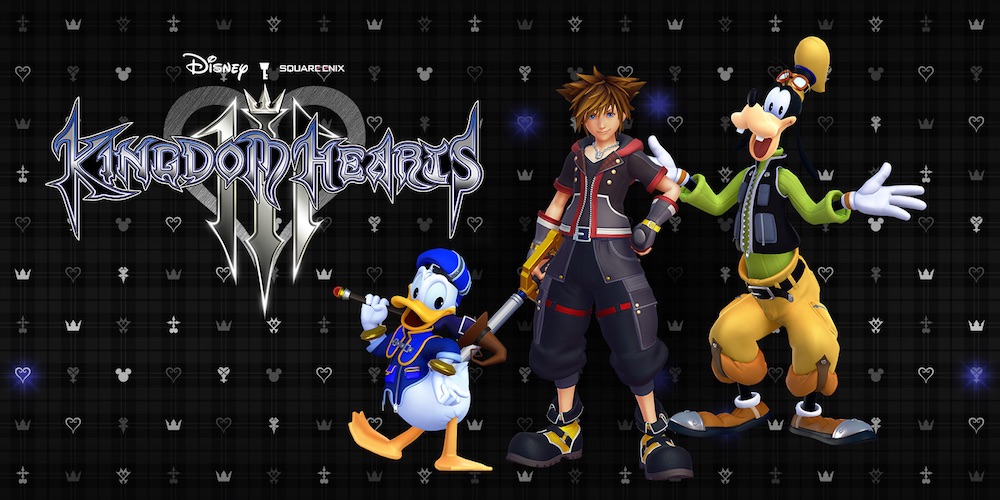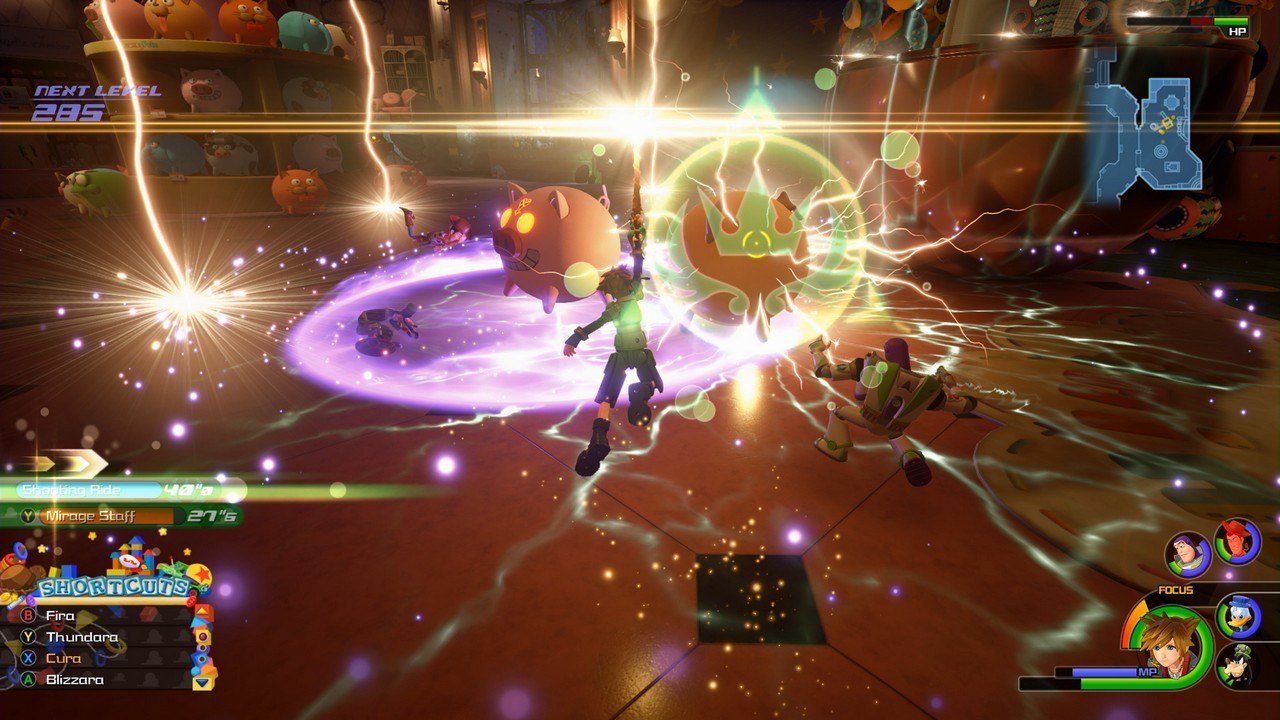
Before playing Kingdom Hearts 3 (KH3), I went back and re-read my take on the 2.8 release of Dream Drop Distance and was blown away by the sheer number of backhanded compliments I dropped throughout my review. The reason why I’m so shocked is because KH3 has opened up a part of my heart that I’d sub-consciously blocked off for some time. I played the original Kingdom Hearts back in 2004, which was a tumultuous year for me. It was a time in my past where I felt alone, angry and confused, and there were very few rays of light in my life. Kingdom Hearts was one of those lights.
While I’m not sure anyone can truly claim to understand Kingdom Hearts, it’s essentially the story of a young boy, Sora, who unabashedly wears his heart on his sleeve and believes in the power of friendship and heart. It’s a story that preaches the message that if you believe in yourself and your friends enough, no obstacle is insurmountable. For a time, KH3 reminded me what it felt like to be that kid who went along for that ride with Sora, Goofy and Donald all those years ago. I forgot that I was an adult with stress, bill and responsibilities, and basked in the youthful exuberance that lies at the core of Kingdom Hearts. I can appreciate why some may view the series as corny or saccharine, but I believe we’ve all perhaps become too cynical with age. With the rise of gritty realism in our media becoming more and more predominant, I feel like a large part of what makes franchises like Disney so magical has started to slip the minds of the very kids who grew up with it.

For the diehard fans, KH3 gives us the long anticipated culmination of the Dark Seeker Saga, which has spanned over 17 years and eleven individual releases (barring HD re-releases). Sora is once again joined by his friends Donald and Goofy, who are charged by the wizard Yen Sid to aid the young keyblade wielder in restoring his lost powers and gaining the power of “Waking” to overcome the big bad Xehanort. The narrative direction does a great job of providing attention to all elements of the story, with focus also being placed on the tandem of Riku and King Mickey, as well as Kairi and Lea amongst many others as they undertake their own personal journeys heading towards the series definitive conclusion.
If I was to pick a particular sticking point that I have with KH3, it’s that it definitely feels more like a “Disney-only” game with a pretty notable absence of Square Enix representation on the whole. Given how integral Square characters such as Squall and Cloud were earlier in the series, it’s a shame to see that not a great deal of focus has been placed on more contemporary SE franchises despite series creator Tetsuya Nomura feeling that they would detract from the story. For new players who’re unfamiliar with the story, I also firmly believe it remains largely inaccessible to anyone who hasn’t been following the series since the beginning. Although KH3 offers a “Memory Archive” section which covers some of the major plot points of the previous releases, there’s a lot of lost sub-text and intricate narrative which is ultimately lost in translation.

In a return to form, KH3 plays much like its predecessors with a free-flowing combat style that lends itself to the series well but also touches on some of the popular elements of the handheld releases. One of the most significant new additions specifically comes from the introduction of “Attraction Flow,” which are special party abilities featuring famous Disney rides such as the Mad Tea Cups. Secondly, each keyblade obtained by Sora comes with its own unique abilities and transformation while also changing his appearance/outfit. My personal favourite comes from the Toy Story world, with the “Power Form” ability morphing the keyblade into a huge hammer and then a massive drill, which is an excellent combination for clearing excessive waves of enemies while also maintaining relatively strong damage. Combat can also be wildly varied by your approach, with the ability to switch between multiple keyblades via the active combat menu. Coupled with the ability to execute solo/team moves as well as each world offering specific gameplay elements such as the Gigas robots in Toy Story, KH3 provides the most comprehensive gameplay the series has seen to date. At times, I feel that being so spoiled for choice made the combat feel quite spammy and a mad rush of just pushing different buttons to see what sticks. However, this remains very true to the origins of the series and is something that’s easier to look past after time spent with the game.
This more open-world approach also carries on through the Gummi Ship sections, which are much broader in scope than in previous titles. Despite my mixed feelings towards the Gummi Ship portion of the franchise, it’s definitely the best iteration that has ever been on offer and feels much less like a tedious chore than it usually does. This time around, you’re able to either use the ship to explore in a more free-roaming sense than the previously linear travel, or combat which offers a broader selection of enemies than its predecessors. If you’re also a fan of Gummi Ship customisation, there are more options than ever before to play around with in terms of builds and style. Cooking mini-games also feature separately in KH3, as you collect ingredients throughout your travels and return to cook dishes with Remy from Ratatouille in a bustling bistro owned by Scrooge McDuck. The purpose of this master class in cuisine and culinary talents is that each recipe provides your party with timed buffs to their stats, which vary in type and quality depending on which dish you cook.

With KH3 also adopting the system of “Flow Motion” refined from Dream Drop Distance, this particular feature opens up the Kingdom Hearts worlds immensely, looping the levels back on themselves, which allows for far more scale and size exploration during discovery gameplay. It helps create a sense of grandiosity with each area and offers a bit more layering to the world levels which earlier entries in the series have been lacking. It also relies on series staples such as trinity marks, which offer even more dynamic interaction with the level environments and makes exploring every nook and cranny of each world a must to find loot and unique experience triggers. A large portion of the game design also focuses around the Gummi Phone, which acts as a central menu storing all your photos, as well as a collection of Game & Watch-esque games, lucky charm images, and many other game feature functions. This provides a nice spin on the more tradition menu system the game has previously taken, and makes it feel a little less arduous to navigate through.
Running on Unreal 4, the traditional style of the series now looks absolutely fantastic on a more modern engine and stays just as captivating and vibrant as it’s always been while offering a whole new level of detail previously unseen. For the longtime fans, a massive wave of nostalgia awaits with the reprisals of Hayley Joel Osment, David Gallagher and Alyson Stoner as Sora, Riku and Kairi respectively. If that doesn’t do it for you, however, newer fans or movie purists are also in for a treat with excellent movie voice acting talents from Big Hero 6 and Frozen just to name a few. Wrapping this all up in a nice bow is the interesting/quirky composition of the title track “Face My Fears” by Hikaru Utada and Skrillex which very much celebrates the music of Kingdom Hearts in the correct manner, and is complemented by an excellent existing soundtrack from the long-standing franchise.

While Kingdom Hearts 3 is definitely a game that represents the apex of its many iterations and one I’d recommend to longtime fans without hesitation, to me it’s so much more than the sum of its parts. There are indeed elements about the game you could fairly criticise, but in a journey that has spanned close to the length of two decades, it’s hard to quantify something that makes you feel so strongly, an intangible essence that is immeasurable in scope and depth. At the very foundation of the series lies a message and courage that I hope never becomes lost, and is something I want to strive to hold in mind every day. It’s unapologetically optimistic and rewinds the clock back to the age of innocence, and in these times I feel like that’s something we could all use in our lives.











